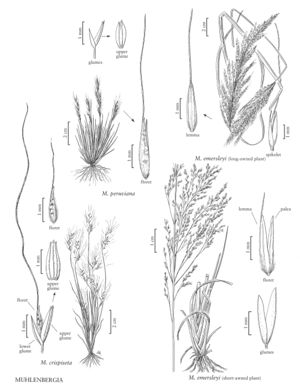Difference between revisions of "Muhlenbergia emersleyi"
FNA>Volume Importer |
imported>Volume Importer |
||
| (7 intermediate revisions by 2 users not shown) | |||
| Line 7: | Line 7: | ||
|synonyms={{Treatment/ID/Synonym | |synonyms={{Treatment/ID/Synonym | ||
|name=Epicampes subpatens | |name=Epicampes subpatens | ||
| − | |authority= | + | |authority= |
| + | |rank=species | ||
}} | }} | ||
|hierarchy=Poaceae;Poaceae subfam. Chloridoideae;Poaceae tribe Cynodonteae;Muhlenbergia;Muhlenbergia emersleyi | |hierarchy=Poaceae;Poaceae subfam. Chloridoideae;Poaceae tribe Cynodonteae;Muhlenbergia;Muhlenbergia emersleyi | ||
| Line 30: | Line 31: | ||
-->{{#Taxon: | -->{{#Taxon: | ||
name=Muhlenbergia emersleyi | name=Muhlenbergia emersleyi | ||
| − | |||
|authority=Vasey | |authority=Vasey | ||
|rank=species | |rank=species | ||
| Line 37: | Line 37: | ||
|basionyms= | |basionyms= | ||
|family=Poaceae | |family=Poaceae | ||
| + | |illustrator=Linda A. Vorobik;Annaliese Miller | ||
| + | |illustration copyright=Utah State University | ||
|distribution=N.C.;Ariz.;N.Mex.;Tex. | |distribution=N.C.;Ariz.;N.Mex.;Tex. | ||
|reference=None | |reference=None | ||
| Line 42: | Line 44: | ||
|publication year= | |publication year= | ||
|special status= | |special status= | ||
| − | |source xml=https:// | + | |source xml=https://bitbucket.org/aafc-mbb/fna-data-curation/src/200273ad09963decb8fc72550212de541d86569d/coarse_grained_fna_xml/V25/V25_763.xml |
|subfamily=Poaceae subfam. Chloridoideae | |subfamily=Poaceae subfam. Chloridoideae | ||
|tribe=Poaceae tribe Cynodonteae | |tribe=Poaceae tribe Cynodonteae | ||
Latest revision as of 17:58, 11 May 2021
Plants perennial; cespitose, not rhizomatous. Culms (50)80-150 cm, stout, erect, not conspicuously branched; internodes smooth for most of their length, smooth or scabridulous below the nodes. Sheaths shorter or longer than the internodes, glabrous or puberulent, basal sheaths laterally compressed, usually keeled; ligules 10-25 mm, membranous throughout, acuminate, lacerate; blades 20-50 cm long, 2-6 mm wide, flat or folded, scabrous abaxially, smooth or scabridulous adaxially. Panicles 20-45 cm long, 3-15 cm wide, loosely contracted to open, light purplish to light brownish; primary branches 1-17 cm, lax, loosely appressed or diverging up to 70° from the rachises, naked basally; pedicels 0.5-3 mm, smooth or scabridulous. Spikelets 2.2-3.2 mm. Glumes subequal, 2.2-3.2 mm, exceeding the florets, scabridulous to scabrous, faintly 1-veined, acute to obtuse, usually unawned, occasionally awned, awns to 0.2 mm; lemmas 2-3 mm, oblong-elliptic, shortly pubescent on the lower 1/2 - 3/4, apices acute, usually awned, sometimes unawned, awns to 15 mm, flexuous, purplish; paleas 1.8-2.9 mm, oblong-elliptic, acute; anthers 1.2-1.6 mm, yellowish to purplish. Caryopses 1.3-1.6 mm, fusiform, reddish-brown. 2n = 24, 26, 28, 40, 42, 46, 60, 64.
Distribution
N.C., Ariz., N.Mex., Tex.
Discussion
Muhlenbergia emersleyi grows on rocky slopes, gravelly washes, canyons, cliffs, and arroyos, often in soils derived from limestone, at elevations of 1200-2500 m, and is also grown as an ornamental. Its range extends from the southwestern United States through Mexico to Panama.
Muhlenbergia emersleyi differs from the closely related M. longiligula in its compressed-keeled sheaths, pubescent florets, and membranous ligules.
Selected References
None.
